Breathless and cold in Colorado
There is very little oxygen in Winter Park, Colorado. I think the people out in California must be...
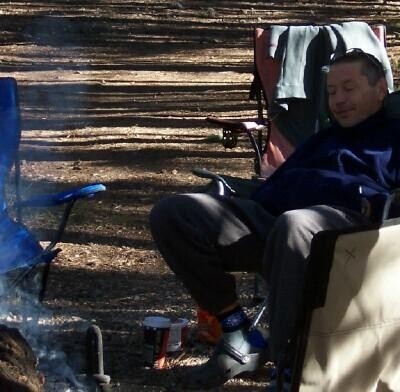
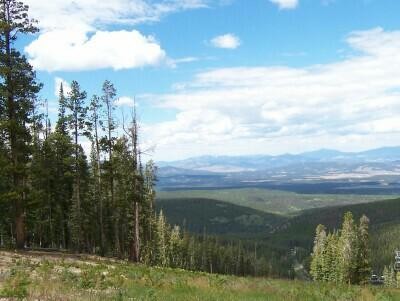
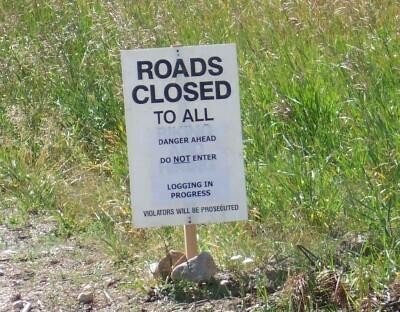
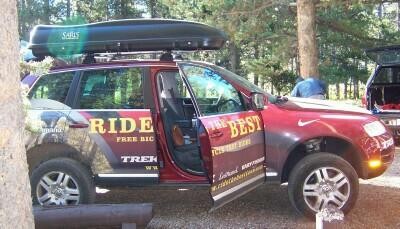
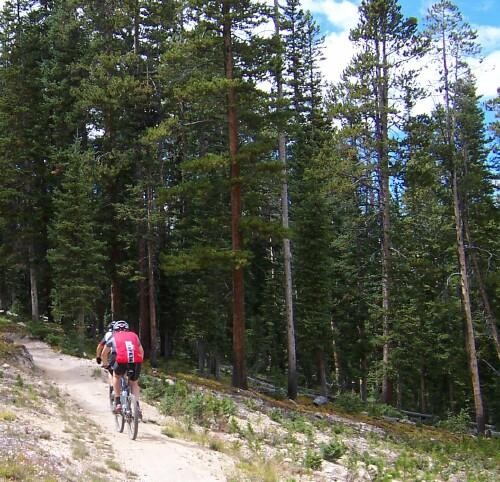
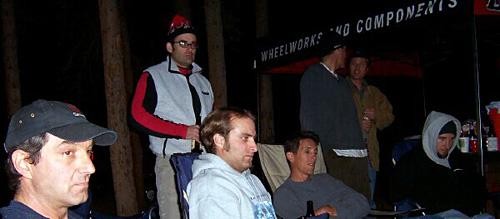
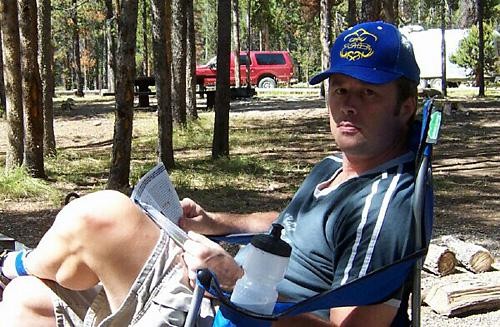
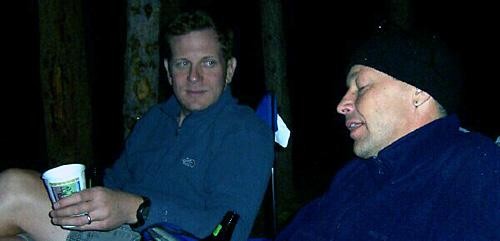
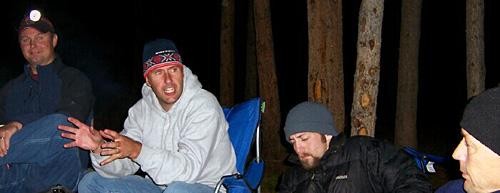
Kona World Challenge 24 hour in Colorado - September 21, 2005
There is very little oxygen in Winter Park, Colorado. I think the people out in California must be hogging it all like they do with the gasoline. Dunno.
The rides I was scheduled to participate in were close to the race site, so I'd get a chance to try out the terrain and the air. The terrain was great, one of the best spots for XC riding I've been to. But the air - the base at Winter Park is around 2700 metres, and the trails around the ski area go up 600 metres or so from there.
Lester and Larry organised the get together. They are the reps in the area and get around to a lot of good shops, so they invited the folks in the shops who ride and work on bikes to attend. There'd be very little discussion about selling things, which is good, because I am out of my element in that topic. We'd be talking tech in between (my) gasps for air.
The first ride was short, an afternoon warm up. And, as is the case with most short group rides, it was brisk. I went OK on the fireroad to the fist climb, and went well on the climb itself for about as long as I can hold my breath, which was not too much of a surprise having raced up in the area in the past. I'd been up for races in Breckenridge a few times over the years (it's also a great XC riding area and 300 metres higher than Winter Park) and knew the feeling well. This time I wasn't coming up to race on the day though; there would be five days of gasping before the actual 24 hour race. Hopefully that would be enough to make it a bit better on the weekend.
The ride went well enough, with some good singletrack climbs and descents. The lads were kind to me for the most part and didn't leave me for dead. The hardtail I'd brought was going to be fine in this area too, as were the fat, smooth tubeless tires as long as it stayed dry.
Dinner after the ride was welcome, and the chat around the fire went fine too. All of that was helped along a bit by the draining of a massive bottle of tequila. Luckily there were a lot of people to help. I took it very easy.
The next day's ride was longer, six hours worth in all, and included a climb to the top of the ski resort. The planned route was closed because of some logging, so we rode up Long trail, a switchback up the ski runs to the top. It took a while, and there wasn't a lot more air to breathe today than there was yesterday. But eventually everyone found there way to the top. From there we'd be descending (almost) all the way back to the campsite and a dinner at a local Mexican restaurant was beaconing.
The long climb went reasonably well for me. The length helps I think because I have to adjust my pace down a little. Unfortunately a 24 hour race is not an endurance event in that respect. The laps are short and the pace is high. Hopefully the rides would help even though the pace I rode was different.
There are quite a few websites that discuss adaptation to elevation and altitude sickness. Check them out if you like. One daunting aspect of this, one that Mr. Ferrentino pointed out with a grim smirk, was that red blood cell count ebbs at around five days. That's race day for me. Thanks Mike. There may be a psychological element of adaptation though (and I am not one to make sense of this, so the next line is purely uninformed speculation). While the lack of oxygen makes going hard difficult, knowing what it is going to feel like makes it easier somehow, less of a panic. Maybe. The two rides were on Tuesday and Wednesday, and I pre-rode the course the next two days a few laps each day, mostly easy but fast enough to get a feel for the climbs and singletrack. Seemed fine. Then it was time to race.
Here is a lap-by-lap account of the race - things were getting a bit cold and crazy by about lap four, so you'll have to keep that in mind while reading...
Laps 1 and 2
As usual I have the impression that everyone else here is fitter and faster than I am after walking around before the race. It's just the way it goes in this area I guess. The team Scott put together is going to be very fast I think. The two guys he found are 35 ish and very strong. They'll be under an hour for sure. I am going last in the order, about 5pm for the first time out. It's sunny and warm, and no threat of rain so far.
The first lap was going pretty good, but I had a mechanical. I blew the middle ring apart. I still got in well under an hour (56 minutes I think, but I have to check the official time). Scott Yule got back in the 51 minute range so I was happy with that. Getting within a few minutes of him is always fine with me.
The mechanical stopped me while I tried to figure out what to do. I couldn't pedal and wasn't even halfway around the course. I managed to pull the remains of the ring out of the crank so I could turn it. Then I could ride on the big ring or the granny. Shifting was tough though, because the chain would fall down between the remaining rings where the middle ring used to be and get stuck.
Once I got going again I started on the granny because there was a climb right after the point where the ring broke. The shift back onto the big ring at the top was clunky, but it eventually worked. Then I tried to ride the rest of the course on the big ring only, which worked for a while - the chain bounced off once.
There was one last climb where I knew I couldn't make it on the big ring so I tried to shift at the bottom before the climb got steep. When I did the chain stuck, and had to get off to fix it. The only guy who passed me on the lap got me there. He'd passed me before that, then I got him back on a short climb (yahoo!), but then he went by me again when I was off the bike fixing the chain. It turns out he is one of the guys on the Colorado Alliance Team that has been beating us in Moab the last few years, named Kelly. Small world. I had a chance to talk to him a little in the start area after that, but only briefly. Seemed like a nice guy (if not a little too fast!). I'll have to buy him a beer in Moab this year.
I did manage to figure out how to shift at the top of that hill after thinking it over on the rest of the climb. It's a curse being an engineer and rider too. I had to shift once with the cranks stopped, then pedaled just enough to get the chain to start to derail (but only enough, no more than a half turn), then shifted again and soft pedaled. The second shift caused the chain to get picked up on the big ring shift pin and keep it from dropping into the gap between the rings. It worked. Same steps worked for the downshift (the other way around of course).
So far we are in second out of 7 teams. The guys in front of us are from Vail, the same guys that gave us some many problems in Moab over the years. Here we go.
The next lap went better. I almost caught the rider from the leading team. I don't catch guys from Vail very often...my lap was two minutes slower than the first lap, but it was the first night lap, and I felt good, so I'll take it. I've been thinking about it and I am not sure how the middle ring came to grief. Maybe the fasteners that hold it onto the arm came loose, though you can usually feel that happening because the chain starts to fall off, and I didn't feel anything.
Chris G is here wrenching for us. She talked to Ariel from the Maverick team and he gave her a new chain ring and bolts for me, so the bike was dialed for the next lap with no effort from me at all. Chris rules. The bike was flawless on the second lap, so it worked out well. I have it way better than I deserve sometimes. I was just happy that I was able to finish the first lap without losing too much time.
Lap 3
On lap number three everything electrical on the bike failed. Both lights went out, and even my mp3 player stopped.
I don't know when the helmet light went out exactly, but it was the first to go. The handlebar light stopped a little over half way around. The LEDs on the handlebar light stayed on though, and that was enough light to climb with. But it is not enough to do anything else (except at painfully slow speeds), so I had to ride behind other riders when I wasn't climbing in order to finish the lap and poach off their light. That's tricky in a small race like this. There aren't that many riders on the course, so I had to try to stick with whoever was there. That can be hard to do.
The causes of these problems are all things I know about and should have anticipated, so it is my fault, not the components. It wasn't much fun thinking through the details that I should have been on top of as I rode without lights. Being stupid sucks.
The helmet mount battery was new, one of the lithium ion batteries Lights in Motion sent me recently. These batteries have shorter run times when they are new, and the cold temperatures (it's f*&king cold!) shorten the available power too. I got caught out badly on this. I used the same battery on the second lap as I did the first lap, even though I had another ready to go. It didn't make it half way around on the second lap. This was a very stupid decision on my part, not a reflection on the battery at all. I had another battery and time to recharge! Duhhh…
The battery on the handlebar-mounted light is one of the first that I made for the niterider set up. After three years of racing it's getting old. I know some of the first batch are short on capacity and run time, but I figured I could always finish the lap on the helmet light. Dumb again. I need to do bench tests on all of these and cull out the ones that don't run long enough before Moab.
Oh yeah - I also had to stop and fix a leak in the rear tyre. The inflation valve was loose and it was leaking slowly. It must have come loose as the tire was checked just before the lap. That's an easy one to fix, except when it's so cold you lack dexterity in your fingers. I fumbled it badly. Luckily, we are still in second with a comfortable margin over third. The rider on the first place team had a slow lap too, so we only lost a minute on them. I think I could have caught him had the lap gone the way it was supposed to. Next lap.
Lap 4
No electrical problems this time. Somehow the front derailleur cage got bent out so I couldn't use the big ring. It was at the bottom of a short climb, and I didn't feel anything weird happen. This is not my weekend. I felt tired on the climbs, especially at first. The lap went OK in most respects though. It took a little over an hour, but that only got about a minute out of the other team. It's better than losing time though. It was cold again too. I had to wipe a layer of frost off my saddle when I put the bike in the waiting area before my lap. The internet weather sites say it's 51F here right now. Something is wrong. I am going to be running out of warm clothes soon.
The sun will be up by the next lap, so that should be better.
We're about six minutes behind the leaders right now, and the gap has been between one and 10 minutes the entire race. The time I have lost to mechanicals is more than the gap. This is a part of racing I have not had trouble with - I'm bummed.
Lap 5
This lap went better, though it was hard to get my legs going on the first uphill section on the course. It came a few minutes in, after a very fast section of flat fire road. It wasn't a big climb, just up enough to make you turn it up in order to get up it quick, and my legs said "wait a minute". Luckily that was about as long as it lasted, and after a few more rollers things got loose and I had some power.
The lap went well and I matched the lap time of the rider on the team we were chasing, but only that, and we stayed about 5 minutes back in second place. I gave it all I could.
Part of the reason for the slow start was that it was getting cold. 28F is much colder that the mid 40s the internet weather sites were calling for. I hadn't brought enough clothing of the sort that I could race in comfortably at those temperatures so I was very cold before the lap, numb hands and feet, stiff legs, and not much better when I was racing. This is Colorado, at elevation, and I knew better.
The other problem was that I was getting worked from the previous laps and it getting hard to recover from those. The laps are short, so I could ride them hard, and not hold back on the pace much at all. The effort required in this race was similar to doing six cyclocross races, back to back, with a little less than three hours to recover in between each. Younger riders seem to have it easier in this respect.
I switched my standard routine between laps around a little to try and compress the recovery process a little. I stuck with the large quantities of Gatoraid and occasional salt and mineral supplements. It worked - I didn't cramp at all, not even a twinge. The main change was to drink a "meal in a can" called "Boost" immediately after each lap, and then about 30 minutes before each lap too. I hoped that it would be easier to digest than solid food so that it could get in quicker. There wasn't enough time to digest food, and having a big lump of it in my stomach after a few laps didn't seem like a good idea to me.
The double shot of Boost supplied about 500 calories so that was almost enough. I took a shot of gel on the trainer before I left for a lap and took another one half way around the course. There was some solid food on my menu as well, couscous and veg, and some Mexican wedding cookies, but not too much of either. It worked out well I think. I never bonked and had decent legs on every lap.
I've been playing around with gel mixes lately. I find gel packets difficult to use as they are in the packet for a few reasons. They can be difficult to open and eat on an MTB course where there are not many sections of trail that are easy enough to ride with one hand on the bar and minimal concentration. And what do you do with the empty packet? I've had to abandon eating one in the middle because I ran out of time (easy trail), and had always put them in my jersey pocket or back under the leg of my shorts to avoid leaving on the course, but that isn't much fun.
So I switched to using a flask and buying the bulk containers of the gel. Hammer Gel plain is my favorite. The bulk gel and flask solves a few problems; they are quick and easy to use, less fiddly than the packets, and there is no wrapper. It's cheaper too.
But the stuff is still hard to gag down when I am going hard. It's too sticky and hangs out in my mouth too long. The recommended bottle of water to chase down the gel is also not easy when you are racing on an off road course - there isn't enough time for it all if the course is technical. My fix for that is to dilute it with lemon juice and water. I add quite a bit of fluid, maybe 15% to 20% to get it thin enough to be able to swallow it in one gulp. The tartness makes me salivate immediately, and that cleans it out of my mouth quickly. I have stopped using water and just use straight lemon juice, fresh if I have time, or something called Real Lemon, which is pretty close to the real thing and available in grocery stores.
Another way to do this is to add the gel to a carb drink and put it in a bottle. I only add enough fluid to thin out the mixture and make it slammable (easy to drink), and enough lemon juice to make it tart. That also makes consumption possible with a very quick move out on the course. I don't drink any fluids on a lap this short, so that is the only bottle I carry. If I wanted some fluids other than that a hydration pack or second bottle would do, but if I am hydrated well between laps I don't need anything on the course.
The sun was up and it was warm again, finally. The weather had been as good as it gets for the entire race really, bluebird skies (the locals say it this way in winter) all the way. Colorado is one of the most beautiful places on earth for a bike race, or any outdoors.
Lap 6
This rotation was the last chance for us. I watched the clock as I sat on the trainer warming up for the lap, and we were five minutes behind when I took off. We all had been giving it to catch them, but they had been doing the same and the gap wasn't getting much smaller. Everything worked for me on the lap, maybe even a little better than I had hoped. The bike was dialed, and though I was sore and tired, I got going once I had warmed up.
I had some sort of lung issues from the lap before. I think I over revved it a bit on the last climb, and had been coughing and wheezing a little, and it was a little painful to breathe when I went real hard on this lap. But it wasn't that restrictive, so I lived with it and did what I could to try to reel the guy in. One of the things that is always a little amazing to me in these events is how I can recover and go hard (relatively speaking) lap after lap. The physiology is simple enough once you've had a chance to practice it.
But the psychological aspects of it are not simple, for me anyway. If you asked me just before the lap how I felt and if I thought I could go fast, I would, based on the way I felt, have to say no. 'I am thrashed, my tank is empty, and I am not going to be able to go.' I tend to get all wound up about it, worrying about whether I'll be able to ride well, how that will work out in the competition, listening to the demons inside. This is not the right way to go about it, something that I have to deal with almost every time I race. I work hard to stay focused, in the moment, positive, all the sports psych dogma. Just keep a "quiet" mind. Trust that I am fit and have done everything between laps that matters. The strategy on the lap will be to keep it simple, and have some fun with it. Go out hard (but not too hard), roll into a fast pace, and then give it all I have.
MP3 players are pretty important to my routine these days, both before and during a lap. A bit of music helps a lot with the quiet mind bit between laps. My playlist for the lap often starts off with some Haka, a live version of the NZ All Blacks rugby team's pre-match ritual - swiped from the Adidas web site. It's a war chant and definitely sets the mood while warming up on the trainer. Today is a good day to die...
That always works out fine, one way or another. It is never automatic though - my confidence is fragile. After competing in so many of these events, I know that my feelings will be misleading. As rough as I feel, once I get out on the course and start pedaling, things start to come around and I can ride. Pretty fun stuff, in a bike racing kind of way.
Get The Leadout Newsletter
The latest race content, interviews, features, reviews and expert buying guides, direct to your inbox!